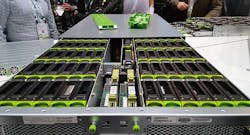Today we continue “Data Driven,” a series of articles examining the volume of data generated by emerging technologies, with a look at the data impact of online video.
On the business side of things, companies depend on video data to track in-store customer traffic and prevent theft. Plus, they create videos to spur purchases and overall interest in a brand.
Whatever its origin, video content is increasingly delivered over the Internet or other online service, and stored in data centers. Given the prevalence of video in the world and the emphasis on using data to drive decisions and provide entertainment, what should people expect in terms of data growth from the video industry?
Cloud Data Centers Will Assist With Storage and Processing
A white paper from IDC predicts the amount of global data in the world will grow to a massive 163 zettabytes by 2025, representing tenfold increase from 2017 levels. The document also projects that enterprises will overtake consumers as the primary creators of data.
So, the question on everyone’s minds is, where and how will people store all that data? As data levels increase, so does the need for data centers, and when video is stored, it is increasingly housed on a a cloud computing service. A report from Cisco suggests that by 2021, cloud-based data centers will account for 53 percent of all data center servers. Video content will likely make up a sizeable percentage of the material stored in the cloud.
Also, some types of video — such as surveillance footage — require extra-speedy processing that occurs before it it goes to a distant data center in the cloud. Manufacturers are creating high-tech cameras with local storage capabilities, plus enabling edge data processing for efficiency. Flash storage and other low-latency solutions help process data without undue delays, too.
Video Apps Feed Users’ Hunger for Content
A few decades ago, people didn’t envision using their smartphones as miniature TVs, but that phenomenon is a reality. Statistics show that people spend 30 minutes per day watching videos on their phones, which is more than time spent consuming that kind of content on PCs or TVs with internet connectivity.
Advertisers want to capitalize on the trend. They plan to collectively spend $20 billion on mobile video content in 2019. It’s not surprising, then, that there is a slew of sites that accommodate people’s love of getting engrossed in videos.
For example, there’s Musical.ly, an app with tens of millions of active monthly users that lets people lip-sync to their favorite tunes and share the resultant videos with friends. Bytedance, a Chinese tech company, acquired Musical.ly for a figure that was reportedly as much as $1 billion in late 2017.
In April, Snapchat encouraged its users to participate in video creation and consumption by introducing a group video chat feature. There’s also Fam, an app that lets up to 16 friends and family members converse with each other via video by using iMessage. It raised $1.8 million in funding last year at a time when it ranked as one of the top 25 social networking apps on the App Store.
Some video-streaming apps and sites let people avoid ever turning on the TV. There’s Twitch, which encourages binge-watching by offering an expansive assortment of television episodes, as well as live streams of popular gamers. The amount of data used while watching Twitch for an hour varies based on factors like bitrate and resolution. However, some people report totals of over 1 gigabyte when streaming at the maximum bitrate.
The YouTube Factor
Then, there’s YouTube, perhaps the most famous video-streaming hub, and one that’s not going away anytime soon. The data consumed there also depends on the quality level people prefer. High-quality options consume several hundred megabytes in only 10 minutes, according to insights from the site’s user base.
Video requires lots of data storage. This Microsoft storage unit has 96 bays for hard disk drives in a JBOD (Just A Bunch of Disks) configuration. It can use 14TB drives for a max capacity of 1.2 petabytes in a 4U chassis. (Photo: Rich Miller)
One of the reasons why people flock to YouTube so frequently is that doing so allows them to find a never-ending supply of clips. People upload 100 hours worth of new material to YouTube every minute.
People love indulging in their favorite TV shows and movies on Netflix, too. The streaming site published data that indicated users around the world watch 140 million hours worth of content on the site daily, and the average member watches 60 films on Netflix per year for more than 90 minutes per day.
And, the enormous amount of data isn’t the only factor increasing usage. People often skip around to different clips before settling on the ones that interest them the most. That habit means they might download clips without watching them, which increases the overall data volume generated.
It may not be long before people start showing their preference for shorter video clips – especially individuals from Generation Z. Predictions about video consumption in 2018 mention that Gen Z loves bite-sized videos, and that brands need to get on board and deliver them.
However, shorter video length does not necessarily mean a decrease in engagement. Video lovers could begin watching more short videos than they do now, potentially using as much data as while enjoying longer videos but fewer of them.
Plus, Gen Z isn’t incapable of long viewing sessions. Data from a Deloitte study released in 2017 found that Gen Z and millennials both watched an average of five hours of content during each binge-watching session, and people from those generations spend about half their time viewing content on devices other than TVs, such as smartphones or tablets.
Smart Home Gadgets on Increases in Video Data
Video cameras have been commonly seen in department stores, sports stadiums, train stations and other public places for decades. However, recent improvements in technology geared toward consumers created an estimated $47 billion market for home security systems.
The most advanced systems used by consumer have face-recognition technology and let people watch hours of collected footage stored in the cloud. There are video gadgets for particular purposes too, such as those video doorbells that give glimpses of visitors on the porch when the doorbell rings or even help people keep watch on their pets while working at the office.
Samsung is among the brands that market a refrigerator with a screen on the front. One model it sells can sync with a Samsung smart TV and broadcast video content simultaneously in the kitchen while it plays on the television in another room.
The Amazon Echo Show brings video to any surface in a home. (Photo: Amazon)
People who own an Echo Show from Amazon get all the Alexa-specific features associated with the company’s family of smart speakers, plus the ability to watch YouTube and Netflix on the gadget or stay in touch with friends through video calls.
Smart gadgets give people more choices as they decide how and where to consume video. People used to solely watch things on TVs and DVD players before smartphones and tablets became so widespread. Now, the opportunity to watch videos is always within arm’s reach on a portable device equipped with a screen.
Online Video Is Here to Stay
The analysis above highlights how there’s no single factor motivating humans’ fascination with online videos. People have devices that stream content in seconds, not to mention dozens of apps that encourage them to interact with friends by sharing videos.
Also, forecasts indicating enterprises will eventually create even more videos than consumers signifies advertisers realize how online video content is one proven way to capture attention they want to emphasize in the years to come.
Online videos define how many people spend their time. That type of content has become a permanent fixture on the societal landscape, especially for entertainment and socialization purposes.
Image by Freestocks.org


